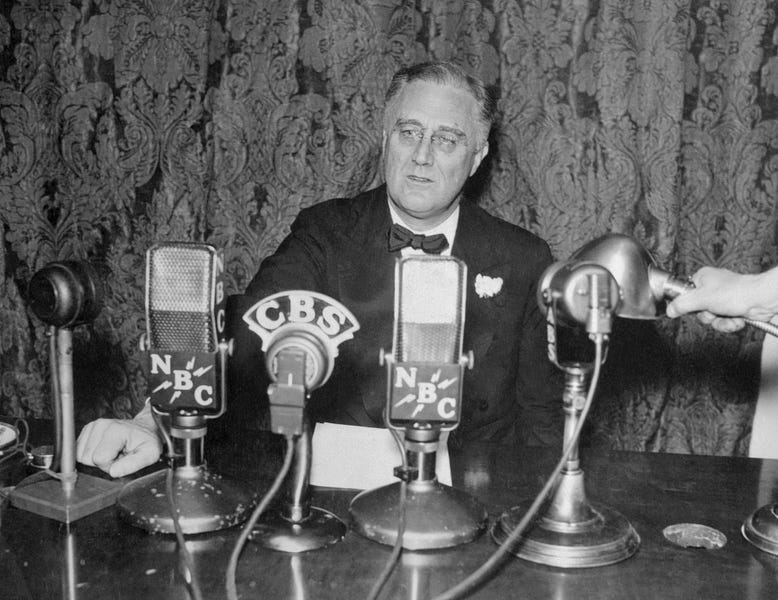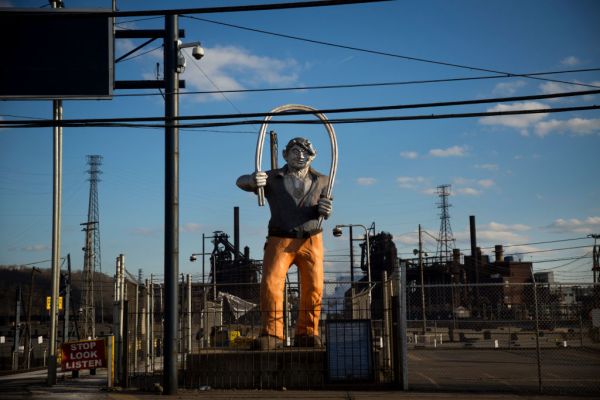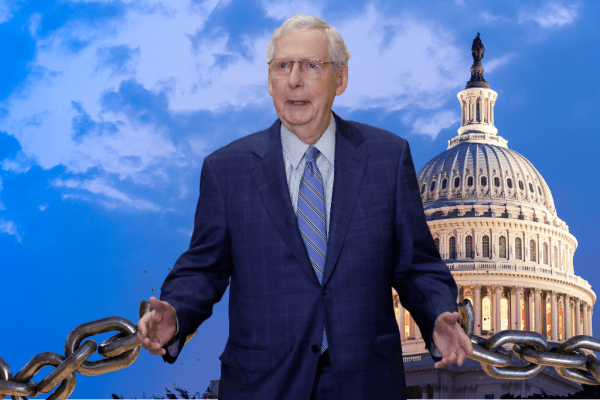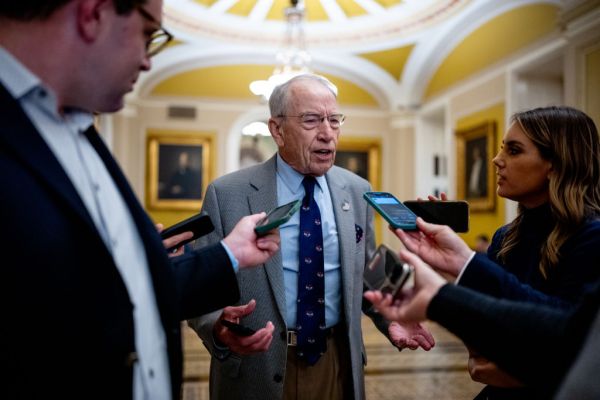Time took some ribbing last week for declaring 2020 the “worst year ever”—a title that surely belongs to, say, the Black Death of the 1353 or the crop-killing gloom of 536. The teasing was deserved. While it’s common in stressful moments to think things have never been worse—and there are plentiful reasons to worry when looking at today’s political horizon, dominated by media-savvy demagogues willing to ignore longstanding legal principles—the truth is that much of what Americans are witnessing today has a precedent, specifically in the bleak 1930s, when the nation was beset by manipulative politicians who exploited cutting-edge technology to expand their power and undermine the Constitution. Much of this history has been buried under saccharine sentiment about the New Deal, but the fact is that the era of Franklin Roosevelt has much in common with the political crises of today.
Elected in 1932 by promising to “reduce the cost of the current Federal Government operations by 25 percent,” Roosevelt actually had little if any governing philosophy at all. He was a brilliant manipulator of people, both in person and en masse, but he combined his affable demeanor with an almost total ignorance of economics and a cynical willingness to exploit his authority. Influential media personalities, meanwhile, convinced that Washington gridlock had paralyzed the country’s response to the Depression, rallied to his side. Columnist Walter Lippmann said America needed “a mild species of dictatorship,” and William Randolph Hearst, who helped ensure Roosevelt’s nomination by the Democrats, financed a film called Gabriel Over the White House, in which the new president took orders directly from Heaven. On inauguration day, a New York Times reporter wrote that Americans were giving Roosevelt “the authority of a dictator” as “a free gift. … America today literally asks for orders.”
In his inaugural address, the president said he would act as if the nation were at war, regardless of what Congress did—and he followed through. He closed banks, took the country off the gold standard, and began dictating arbitrarily how much the dollar would be worth—changing its value each day, and sometimes basing it on “lucky numbers.” He increased government spending astronomically, and balanced that with heavy new taxes, in ways that obstructed the economy’s ability to right itself, and maximized government control over economic choices. He doubled down on make-work projects such as the Works Projects Administration (WPA) and the Civilian Conservation Corps (CCC), which enabled him to funnel money directly to politicians whose support he wanted. And he surrounded himself by what historian Gary Dean Best calls “a plethora of ‘crank’ economists” with nutty ideas about controlling industry.
Foremost among these was the National Industrial Recovery Act (NIRA). Modeled on the economic plans of Italy’s dictator Benito Mussolini—who praised Roosevelt’s book Looking Forward as “reminiscent of the ways and means by which Fascism has awakened the Italian people”—it outlawed what the administration viewed as “unfair” competition and established a group of national industrial cartels. Another law, the Agricultural Adjustment Act (AAA), sought to raise food prices by paying farmers to grow less, which was dubious enough in a time of Depression and the Dust Bowl, but was worsened by the fact that it conflicted with the policy of another New Deal program, the Resettlement Administration (RA), which tried to move farmers off of exhausted land to places where they could grow more.
Soon, butchers and dry cleaners across the country were being jailed under the NIRA for charging low prices, and farmers were ending up in refugee camps thanks to AAA and RA policies that gave them little reward for their skills before evicting them from their property. Roosevelt and his wife began contemplating ways to conscript Americans into “national service,” a scheme that was already being implemented with seeming success in Germany. Eleanor was not only an enthusiast for conscripted labor, but for back-to-the-land schemes such as the Subsistence Homestead Division, which, like the RA, aimed to move farmers off their land onto government-funded agricultural communes inspired by similar projects in Italy and Germany. Experimental communes such as Arthurdale and Jersey Homesteads failed after wasting millions of taxpayer dollars.
Much like today, the political scene of the 1930s had an immensely influential new media technology: radio. Capable of bringing a politician’s voice into voters’ very living rooms, radio’s impact was light-years beyond that of newspapers or motion pictures, and Roosevelt was keen to take control. He oversaw the establishment of the Federal Communications Commission, which revamped existing federal laws under which radio stations were licensed. Now broadcasters would have to ask the new commission—staffed with Roosevelt’s deputies—for permission to operate every six months.
The results were predictable. Commissioner Harold Lafount told broadcasters it was their “patriotic duty” to deny advertising time to anyone “disposed to defy, ignore, or modify” the administration’s economic policies. And CBS Vice President Henry Bellows said that “no broadcast would be permitted” over his network “that in any way was critical of any policy of the administration.” Meanwhile, Roosevelt took to the radio with countless speeches in which he portrayed himself as fighting singlehandedly for the common man against nefarious millionaires in Washington. He had little compunction about lying to his listeners, as in a speech delivered two days after the Nazi invasion of Poland in which he insisted that “no man or woman” should “thoughtlessly or falsely talk of America sending its armies to European fields,” when he was planning just that.
Roosevelt’s handling of the print media was subtler. Instead of outright censorship, he got reporters to cooperate with the administration—in part by hiring them onto the payrolls of new publicity departments at federal agencies (which were illegal). The New Deal’s congressional supporters assisted by humiliating or threatening opponents. In 1935, Sen. Hugo Black began using his chairmanship of the Lobby Investigation Committee to intimidate anti-New Deal forces in a manner that would be imitated by the McCarthy hearings of the ‘50s and the witch-hunts for “dark money” today. On one occasion, he subpoenaed every telegram Western Union delivered to the Capitol relating to one piece of legislation—a move a federal court later declared illegal but was powerless to stop. When a constituent wrote to complain that Black was “making mountains out of molehills,” Black asked the district attorney in the man’s hometown to investigate him. After Roosevelt placed Black on the Supreme Court, Sen. Sherman Minton took over and continued this abuse of investigative powers. He subpoenaed the publisher of a magazine called Rural Progress and demanded to know why it showed insufficient support for Roosevelt. “Your magazine,” he scolded, “has persistently attempted to persuade its readers that the pending wage-hour legislation should not become law. … The record fails to show … where you advocate any program of the administration.” When Minton learned that singer Rudy Vallee had donated $5,000 to Rural Progress, he splashed the fact across the newspapers to embarrass him.
Meanwhile, a spineless, anti-intellectual Republican party offered no principled opposition. Instead, it promised voters a diluted form of the New Deal in the form of Alf Landon, its 1936 presidential nominee who told voters that if elected, he would keep Roosevelt’s policies in place. He lost in a landslide.
Roosevelt’s principal opponents were actually other Democrats whose demagogic tactics were even more extreme than his own, such as radio personality Charles Coughlin, and Louisiana Gov. Huey Long, who thought the New Deal didn’t go far enough and proposed that government simply confiscate money from the rich and hand it to the poor. Long exploited public-works projects to enrich his political cronies, taxed opposition newspapers in an effort to silence them, and used state police like storm troopers to intimidate his enemies. Supporters adored him enough that Roosevelt worried about his political future, until Long was assassinated in September 1935.
The Supreme Court’s opposition was harder to measure. First it issued a series of decisions that revoked longstanding legal doctrines standing in the way of the New Deal, such as rules protecting the right to run a business without arbitrary government interference. But a year later, it began to look more skeptically at the administration’s programs. When it seemed poised to declare that Roosevelt had broken the law by nullifying contracts that promised payment in gold, the president drafted a radio speech pledging to “look beyond the letter of the law” and “take such steps as may be necessary, by proclamation” to implement his will despite the court’s decision. The court ruled the other way, so Roosevelt never delivered the message, but only months later, the justices did strike down the NIRA and the AAA, and Roosevelt initiated his infamous “court packing” plan to force the judiciary to heel.
By then, intellectuals watching the rise of fascism in Europe had begun to fear that the president was on a path to outright fascism himself. Foremost among these was journalist Dorothy Thompson, recently expelled from Germany for her reports on Adolf Hitler. She began publishing warnings that Roosevelt was “intent on substituting himself and his own ideas, his own policies, and his own hunches, for the checked and balanced government of this country.” Roosevelt, she wrote, seemed to believe there was a “mystical compact … between him personally and the American people,” and that the constitutional system of checks and balances should be “used or circumvented according to whether they work or not within the spirit of that compact.”
She shared this view with her husband, novelist Sinclair Lewis, whose 1936 book It Can’t Happen Here projected a future United States ruled by a fascist named Buzz Windrip. Critics recognized Windrip as a caricature of Huey Long but ignored the fact that he is just as much as satire of Roosevelt himself. When a group of leftist writers honored the novel with a celebratory dinner, Lewis denounced them from the podium. “I don’t believe any of you have read the book,” he said. “If you had, you would have seen I was telling all of you to go to hell.”
Roosevelt’s court-packing plan failed, but Roosevelt never regretted it. In fact, he later campaigned against fellow Democrats who had opposed it. But the court got the message, and gave up trying to rein in Roosevelt’s excesses. And worse was yet to come. In 1937, the economy began slumping again, thanks to heavy new taxes and regulations. Yet instead of asking whether his own policies were to blame, Roosevelt insisted that the decline was proof of a secret conspiracy of business owners. He called it the “capital strike.”
It was a suspicion he had nurtured for a while; after the court’s ruling in the NIRA case, he had told an assistant, “business has bucked me, and when business wants to play with me again, it will be on its hands and knees.” He told Democratic Party chairman Jim Farley that “business, particularly the banking industry, has ganged up on me,” and Interior Secretary Harold Ickes and Attorney General Robert Jackson backed him up. Insisting that the downturn was a scheme by the country’s “sixty richest families” to “fight to the last ditch to retain such autocratic control over the industry and finances of the country,” Ickes demanded an FBI investigation, and Jackson—who agreed that business owners were engaged in “a new manifestation of ‘aristocratic anarchy’” by not hiring people—complied.
The investigation turned up nothing, but Roosevelt, undeterred, ordered Jackson to initiate a campaign of antitrust cases against big businesses, and organized the Temporary National Economic Committee (TENC) to find ways to make private companies more “democratic”—that is, subordinate to political control.
The consequences soon became clear. When the White House learned that U.S. Steel was considering cutting wages to survive the downturn, it summoned company president Edward Stettinius to a meeting. Wage reductions would hurt the party’s chances in the 1938 midterms, he was told, so if he postponed the cuts, Roosevelt would reward the company by giving it all of the government’s steel orders. When Stettinius hesitated, the president pushed harder: U.S. Steel must delay the cuts or he would sic the TENC and the government’s antitrust lawyers on the company. Stettinius agreed. His cooperation was later rewarded with an appointment as secretary of state.
Roosevelt’s “strike of capital” rhetoric was particularly worrisome in 1938, as the threat of war was inspiring calls for government conscription. This was not necessarily a military proposal, however. Eleanor Roosevelt had long supported the idea of forcing every American to work for the government, and even Dorothy Thompson came to support the idea of compelling the unemployed to join the CCC or the WPA. It only seemed logical to many that if capital was on strike, government should simply confiscate both money and manpower to spur the economy. Many state governments, particularly in the South, were already using “vagrancy” laws for this purpose.
Roosevelt did not openly endorse the idea, but after the European war began, he declared a “limited national emergency” that expanded his already extraordinary powers, and within a year, the nation adopted its first peacetime draft. It also passed the Alien Registration Act, America’s first peacetime sedition law, which basically outlawed criticism of the draft. Roosevelt ordered the FBI to investigate and surveil countless potential subversives, and even took a hand himself in curtailing some of the journalists who criticized him.
Little wonder, then, that Roosevelt’s decision to run for a third term struck many as only one small step below dictatorship. With its expansion of political control over the economy, private property, and free speech, the New Deal had already obliterated countless cultural and constitutional precedents. Canceling elections did not seem out of the question.
The war that followed—and later the Cold War—did much to erase the memory of a decade of crisis when leading American intellectuals openly called for dictatorship, censorship, and conscription. Americans eventually rallied again to the ideas of free enterprise and limited, constitutional government, viewing these as essential to what the nation was fighting for. But as a result, many would forget that, in Ira Katznelson’s words, “the New Deal was a moment when the most fundamental contours of politics, including political institution, language and values, were deeply unsettled. … A climate of universal fear deeply affected political understandings and concerns.”
Timothy Sandefur is vice president for litigation at the Goldwater Institute and author of The Right to Earn a Living (Cato Institute, 2010).








Please note that we at The Dispatch hold ourselves, our work, and our commenters to a higher standard than other places on the internet. We welcome comments that foster genuine debate or discussion—including comments critical of us or our work—but responses that include ad hominem attacks on fellow Dispatch members or are intended to stoke fear and anger may be moderated.
You are currently using a limited time guest pass and do not have access to commenting. Consider subscribing to join the conversation.
With your membership, you only have the ability to comment on The Morning Dispatch articles. Consider upgrading to join the conversation everywhere.